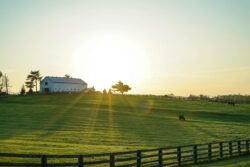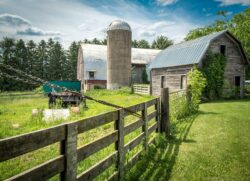Kentucky Bluegrass, or Poa pratensis, is not actually blue, nor is it originally from Kentucky.
This popular grass owes its name to the bluish-purple buds that appear when it’s allowed to grow to its full height, and to the fertile soils of Kentucky where it thrived when Europeans settled in America.
The Origins of Kentucky Bluegrass
From Europe to American Meadows
Kentucky Bluegrass is native to Europe, Asia, and Northern Africa.
It was introduced to North America by European settlers and traders.
Despite its name, this grass found its way into the American landscape, particularly thriving in the northern regions of Kentucky, which were known for their vast meadows of blue-flowered grass.
The Blue in Kentucky Bluegrass
The “blue” in Kentucky Bluegrass comes from its bloom.
When allowed to grow naturally, Kentucky Bluegrass produces small blue flowers that give fields a bluish tint from a distance.
However, since the grass is commonly kept mowed in lawns and parks, this characteristic blue hue is rarely seen, leaving many to wonder about the name’s origin.
FAQs on Kentucky Bluegrass
Q: Is Kentucky Bluegrass actually blue?
A: Kentucky Bluegrass is green for most of its lifecycle. The “blue” refers to the small blue flowers it produces when allowed to reach its natural height.
Q: Why is it associated with Kentucky?
A: The grass became synonymous with Kentucky due to the fertile soils of the region that supported vast meadows of the grass, which were notably full of blue-flowered grass when Europeans named the area.
Q: Can Kentucky Bluegrass grow outside of Kentucky?
A: Yes, Kentucky Bluegrass is a versatile and hardy grass that can thrive in a wide range of climates, making it a popular choice for lawns across the United States.
Q: How did Kentucky Bluegrass become so widespread in the United States?
A: Kentucky Bluegrass spread across the United States primarily through European settlers who brought it over for its use as pasture grass.
Its adaptability to various climates and conditions allowed it to thrive far beyond Kentucky, becoming a dominant lawn and pasture grass across the country.
Q: Does Kentucky Bluegrass only grow in cool climates?
A: While Kentucky Bluegrass is a cool-season grass, meaning it thrives in cooler temperatures, it has a remarkable ability to adapt to a range of climates.
It performs best in regions with cold winters and warm summers but can be found in various environments across the United States due to its hardiness.
In Summary
- Kentucky Bluegrass is named for its small blue flowers and the fertile soils of Kentucky.
- It is native to Europe, Asia, and Northern Africa, not Kentucky.
- The grass thrives in a wide range of climates, making it popular across the United States.
Sources and Further Reading
- Wonderopolis: Is Bluegrass Really Blue? – This article explores the misconception about the color of Kentucky Bluegrass and delves into its origins and naming.
- Wikipedia: Poa pratensis – Provides a comprehensive overview of Kentucky Bluegrass, including its taxonomy, ecological role, and distribution.
- Oregon State University: Kentucky Bluegrass, Poa pratensis L. – Offers detailed information on the botanical characteristics, history, and cultivation of Kentucky Bluegrass.


